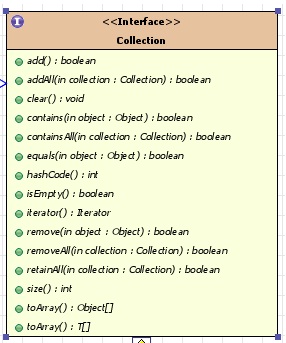菜鸟的Java源代码分析--Vector类
Vector类:
为了更好的从宏观上理解Vector,我们可以首先看一下Vector的父类以及实现的一些Interface:
?
Vector作为一种容器,实现了Collection这个接口,并继承AbstractList这个“直接父类”。同时,我们还能看到,Vector和他的父类AbstractList都实现了List这个接口,表明Vector是一种List类型的容器(其他的有比如Map型)。
综上,用集合的思想来看Vector的逻辑地位:Collection > List > Vector ,Vector是所有容器的一条分支。
?
由UML图,可以看到Vector的这个类在设计时的逻辑构架,作为一个菜鸟,除了五花八门的算法,这种高级的面向对象的设计思想,是初学者更应该去把握的。?
下面来Trace Code:Interface Collection:
Collection是所有容器的根,定义了了Collection应该去实现的方法Method,见下图:
?
public abstract class AbstractCollection implements Collection { protected AbstractCollection() { super(); } public boolean add(E object) { throw new UnsupportedOperationException(); } public boolean addAll(Collection extends E> collection) { boolean result = false; Iterator extends E> it = collection.iterator(); while (it.hasNext()) { if (add(it.next())) { result = true; } } return result; } public void clear() { Iterator it = iterator(); while (it.hasNext()) { it.next(); it.remove(); } } public boolean contains(Object object) { Iterator it = iterator(); if (object != null) { while (it.hasNext()) { if (object.equals(it.next())) { return true; } } } else { while (it.hasNext()) { if (it.next() == null) { return true; } } } return false; } public boolean containsAll(Collection> collection) { Iterator> it = collection.iterator(); while (it.hasNext()) { if (!contains(it.next())) { return false; } } return true; } public boolean isEmpty() { return size() == 0; } public abstract Iterator iterator(); public boolean remove(Object object) { Iterator> it = iterator(); if (object != null) { while (it.hasNext()) { if (object.equals(it.next())) { it.remove(); return true; } } } else { while (it.hasNext()) { if (it.next() == null) { it.remove(); return true; } } } return false; } public boolean removeAll(Collection> collection) { boolean result = false; Iterator> it = iterator(); while (it.hasNext()) { if (collection.contains(it.next())) { it.remove(); result = true; } } return result; } public boolean retainAll(Collection> collection) { boolean result = false; Iterator> it = iterator(); while (it.hasNext()) { if (!collection.contains(it.next())) { it.remove(); result = true; } } return result; } public abstract int size(); public Object[] toArray() { int size = size(), index = 0; Iterator> it = iterator(); Object[] array = new Object[size]; while (index T[] toArray(T[] contents) { int size = size(), index = 0; if (size > contents.length) { Class> ct = contents.getClass().getComponentType(); contents = (T[]) Array.newInstance(ct, size); } for (E entry : this) { contents[index++] = (T) entry; } if (index it = iterator(); while (it.hasNext()) { Object next = it.next(); if (next != this) { buffer.append(next); } else { buffer.append("(this Collection)"); //$NON-NLS-1$ } if (it.hasNext()) { buffer.append(", "); //$NON-NLS-1$ } } buffer.append(']'); return buffer.toString(); }}??
//AbstractCollection 抽象的实现了Collection这个接口的所有方法,没有存在任何具体的Method,因为所有遍历过程都依赖于自身的迭代器。
举个例子:
public void clear() { Iterator it = iterator(); while (it.hasNext()) { it.next(); it.remove(); } }照着设计者的意思,加黑这句代码iterator()指望着子类去实现了,所有的框架都给你搭好了,子类或者任何具体的容器要去实现这个迭代器,更进一步说,具体容器的数据结构与迭代器紧密相关,文邹邹说起来这叫耦合度高。在这里,一切都是个模子。小总结:
1、方法却是一个抽象的方法,显然设计者的目的是让所有的ConcreteCollection(具体Collection)去继承抽象的Collection。
2、容器的结构与迭代方式都因自身的种类而不同。
?
困死了,待续。。。。